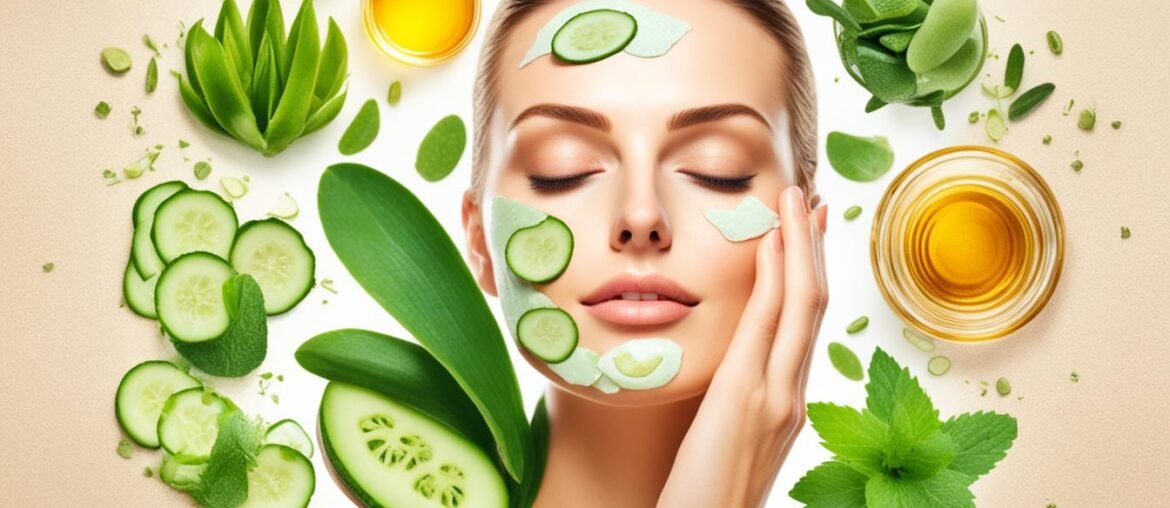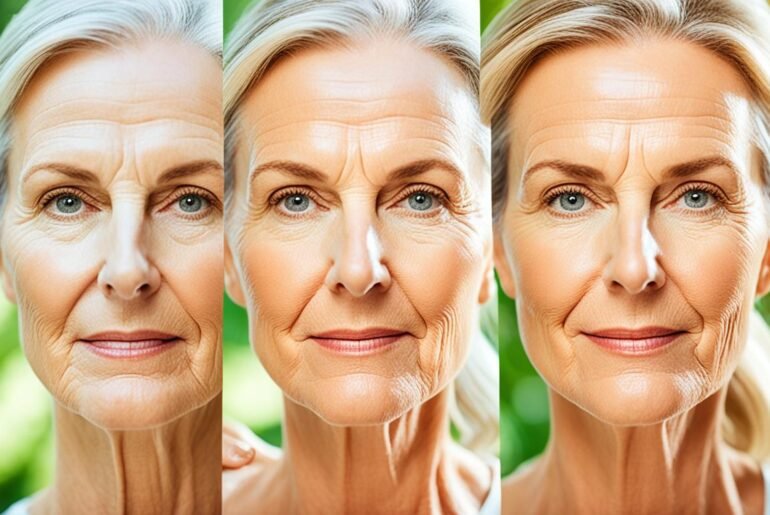Did you know that sunspots, also known as liver spots or solar lentigines, are a common skin condition that affects millions of people? These flat brown spots develop on the skin after sun exposure and are more common in individuals with fair skin and those older than 40. If you’re looking for natural ways to treat sun damaged skin and restore its health and appearance, you’ve come to the right place. In this article, I’ll share with you effective at-home remedies and professional procedures that can help heal and repair sun damaged skin naturally.
Key Takeaways:
- Sunspots are a common skin condition that develops after sun exposure.
- They are more common in people with fair skin and those older than 40.
- Natural remedies and professional procedures can effectively treat sun damaged skin.
- At-home remedies include aloe vera, licorice extract, vitamin C and E, apple cider vinegar, green tea, and more.
- Professional treatments include laser resurfacing, IPL, cryotherapy, chemical peels, and microdermabrasion.
At-Home Remedies for Sun Damaged Skin
When it comes to treating sun damaged skin, there are plenty of effective and natural remedies that you can try in the comfort of your own home. These remedies can help fade or even remove sunspots on the face, leaving your skin looking fresh and rejuvenated. Let’s explore some of the most popular at-home treatments for sun damaged skin.
Aloe Vera
One of the best natural remedies for sun damaged skin is aloe vera. This plant contains compounds that can lighten sunspots and promote overall skin health. Simply apply aloe vera gel directly on the affected areas and leave it on for about 15-20 minutes before rinsing off. Repeat this process daily for best results.
Licorice Extract
Licorice extract is another powerful ingredient that can help lighten skin discoloration caused by sun exposure. It contains antioxidants and anti-inflammatory properties that can soothe the skin and even out its tone. You can find licorice extract in the form of creams or serums, or you can make your own DIY mask by mixing licorice powder with aloe vera gel or honey.
Vitamin C
Vitamin C is a natural antioxidant that protects the skin from UV rays and lightens dark spots. You can apply vitamin C serums or creams directly on the sunspots or consume foods rich in vitamin C. Citrus fruits, strawberries, bell peppers, and kale are all excellent sources of vitamin C.
Vitamin E
Vitamin E is known for its ability to improve skin health and lighten sunspots. You can apply vitamin E oil directly on the affected areas or take vitamin E supplements orally. Another option is to incorporate foods rich in vitamin E, such as almonds, spinach, and avocado, into your diet.
Apple Cider Vinegar
Apple cider vinegar has natural acids that may help lighten skin pigmentation and improve the overall appearance of the skin. Dilute apple cider vinegar with water and apply it to the sunspots using a cotton ball. Leave it on for a few minutes before rinsing off. However, be cautious as apple cider vinegar may cause irritation for sensitive skin types.
Green Tea
Green tea has antioxidant and depigmenting properties that can help fade sunspots. Brew a cup of green tea and let it cool down. Then, dip a cotton ball into the green tea and apply it directly on the affected areas. Leave it on for about 15 minutes before rinsing off. You can also freeze the brewed green tea as ice cubes and gently rub them on the sunspots for a cooling effect.
Black Tea Water
Black tea water has been shown to lighten tanned spots on the skin. Brew a cup of black tea and let it cool down. Dip a cotton ball into the black tea water and apply it directly on the sunspots. Leave it on for a few minutes before rinsing off. Repeat this process regularly for best results.
Red Onion
Red onion contains ingredients that could lighten the skin and reduce the appearance of sunspots. Extract the juice from a red onion and apply it on the affected areas using a cotton ball. Leave it on for about 10 minutes before rinsing off. Be aware that red onion juice may have a strong smell, so it’s best to do this treatment in the evening.
Lemon Juice
Lemon juice is a common ingredient in many skin lightening creams. Its natural acidity helps lighten sunspots and even out the skin tone. Simply apply fresh lemon juice directly on the affected areas using a cotton ball and leave it on for about 15 minutes before rinsing off. However, be cautious as lemon juice may cause dryness or irritation for some individuals, so it’s recommended to dilute it with water before application.
Buttermilk
Buttermilk contains lactic acid that may help lighten sunspots. Soak a cotton ball in buttermilk and apply it directly on the affected areas. Leave it on for about 15 minutes before rinsing off. Repeat this process regularly for noticeable results.
Milk
Milk also contains lactic acid and can lighten sunspots when applied topically. Soak a cotton ball in milk and apply it directly on the sunspots. Leave it on for about 10-15 minutes before rinsing off. Regular application of milk can help improve the appearance of your skin.
Honey
Honey is known for its skin-healing properties and can promote new cell growth. Apply a thin layer of honey directly on the sunspots and leave it on for about 10 minutes before rinsing off. Regular use of honey may help fade sunspots and improve the overall texture of your skin.
Over-the-Counter Creams
Over-the-counter creams containing ingredients such as glycolic acid, hydroxy acid, kojic acid, or deoxyarbutin can also help lighten sunspots. These creams work by exfoliating the skin and reducing the production of melanin, which is responsible for skin pigmentation. Look for products that are specifically formulated for sun damaged skin and follow the instructions carefully for best results.
Using these at-home remedies for sun damaged skin can help fade or remove sunspots over time. However, it’s important to note that results may vary depending on the individual and the severity of the sun damage. If you have any concerns or if the sunspots persist despite these remedies, it’s always a good idea to consult a dermatologist for further evaluation and treatment options.
In the next section, I will discuss professional procedures for sun damaged skin that can be performed at a clinic or by a trained skin care professional.
Professional Procedures for Sun Damaged Skin
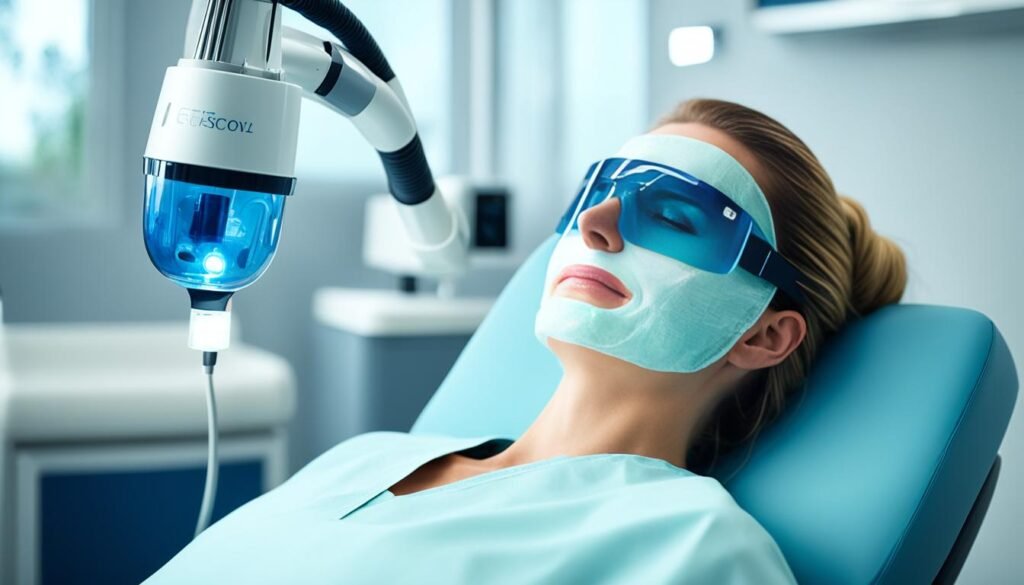
When it comes to treating sun damaged skin, professional procedures offer effective solutions. These procedures should always be performed by a trained skin care professional to ensure safety and optimal results. Here are some of the commonly used professional treatments for sun damaged skin:
Laser Resurfacing
Laser resurfacing is a popular treatment that uses beams of light to remove sun damaged skin and stimulate the growth of new, healthier skin cells. This procedure can effectively reduce the appearance of sunspots and improve overall skin texture and tone.
Intense Pulse Light (IPL) Therapy
IPL therapy targets sunspots on the skin using light energy. The intense pulses of light destroy the excess melanin responsible for the discoloration, leading to a more even skin tone. IPL therapy is a non-invasive treatment that can yield noticeable results.
Cryotherapy
Cryotherapy involves freezing off sunspots with liquid nitrogen. The freezing temperature destroys the pigmented cells, leading to their gradual elimination and a reduction in the appearance of sunspots.
Chemical Peels
Chemical peels use a solution containing acids to exfoliate the outer layer of the skin. By removing damaged skin cells, chemical peels promote the growth of new, healthier skin. This can help fade sunspots and improve overall skin complexion.
Microdermabrasion
Microdermabrasion is a gentle exfoliation technique that involves using an abrasive tip to remove the outermost layer of the skin. This procedure helps to improve skin texture and reduce the visibility of sunspots. Microdermabrasion is a non-invasive treatment with minimal downtime.
These professional procedures for sun damaged skin can be highly effective in removing or reducing the appearance of sunspots. It’s important to consult with a skin care professional to determine the most suitable treatment option for your specific needs.
Risks and Prevention of Sunspots
Sunspots, also known as solar lentigines or liver spots, are common skin discolorations that develop after prolonged sun exposure. While they are generally harmless and noncancerous, it is crucial to differentiate them from more serious skin conditions. In order to do so, it is recommended to consult a doctor if a spot on the skin exhibits the following characteristics:
Darkness – The spot appears significantly darker than the surrounding skin.
Growth – The spot is increasing in size over time.
Irregular Border – The edges of the spot are uneven or irregularly shaped.
Itchiness – The spot is accompanied by persistent itching.
Pain – The spot is painful or tender.
Redness – The spot is red or inflamed.
Bleeding – The spot bleeds or develops an open sore.
Unusual Color – The spot exhibits an abnormal or atypical color.
While the treatments for sunspots are generally safe, it is advisable to consult with a healthcare professional before using any home remedies or undergoing professional procedures. This is particularly important if you have any existing skin conditions or are unsure about the suitability of certain treatments.
To effectively prevent sunspots on the face, it is essential to implement protective measures against harmful UVA and UVB rays. Here are some practical tips for prevention:
- Avoid the sun between 10 a.m. and 3 p.m., when the sun’s rays are the strongest.
- Frequently apply broad-spectrum sunscreen with an SPF of 30 or higher.
- Choose makeup products that contain sunscreen for additional protection.
- Cover the skin with clothing, including long sleeves, pants, and wide-brimmed hats.
By following these precautions and adopting a sun-smart approach, you can significantly minimize the risk of developing sunspots and maintain healthier, more youthful-looking skin.
| Risks of Sunspots | Prevention of Sunspots | How to Prevent Sunspots on the Face |
|---|---|---|
| – Generally harmless and noncancerous | – Avoid the sun between 10 a.m. and 3 p.m. | – Apply sunscreen regularly |
| – Differentiate from more serious skin conditions | – Use makeup products with sunscreen | – Choose clothing for sun protection |
| – Consult a doctor for concerning skin spots | – Wear wide-brimmed hats |
What is Sun Damage?
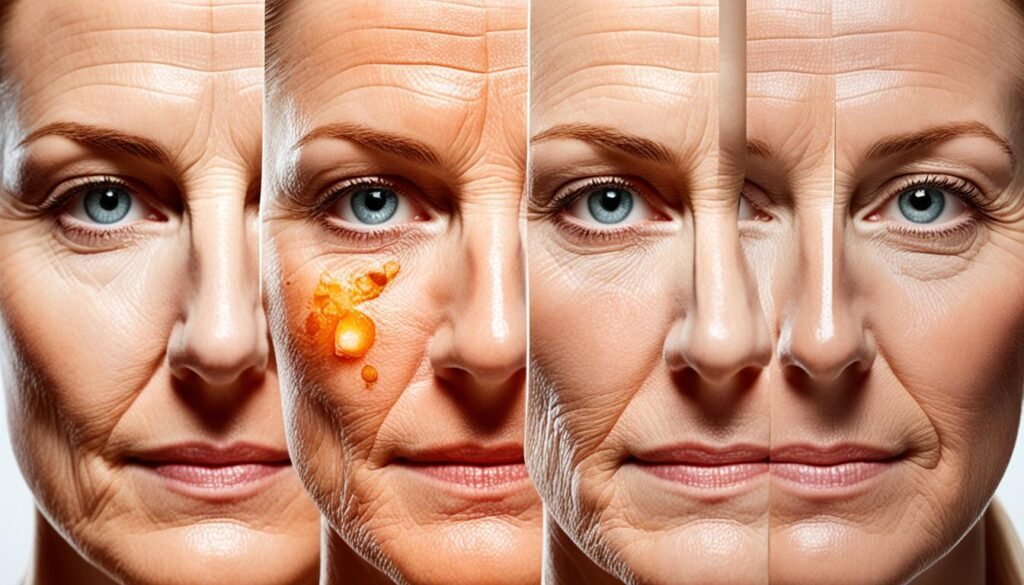
Sun damage refers to the harmful effects caused by overexposure to the ultraviolet (UV) rays emitted by the sun and tanning beds. These UV rays can penetrate the skin and damage the DNA of skin cells, leading to various skin concerns and long-term effects.
One of the most common effects of sun damage is skin aging. Prolonged exposure to UV rays accelerates the breakdown of collagen and elastin, proteins responsible for the skin’s firmness and elasticity. This leads to the development of wrinkles, fine lines, and sagging skin. Sun damage can also result in changes in skin texture, causing it to become rough, dry, and uneven.
It is important to note that sun damage is cumulative, meaning it builds up over time. The effects of childhood exposures to the sun can become more apparent in adulthood. Moreover, sun damage can be worsened by other factors such as air pollution, cigarette smoke, and certain household chemicals. These elements generate harmful free radicals that further damage the skin’s structure through a process known as oxidative photodamage.
“Sun damage can accelerate skin aging, leading to the appearance of wrinkles, fine lines, and changes in skin texture.”
Fortunately, there are natural remedies available to repair and rejuvenate sun-damaged skin. These remedies can effectively address the visible signs of sun damage, promoting a healthier and more youthful complexion.
Steam Cleaning Your Face
Steam cleaning your face is a rejuvenating and purifying method that can have a positive effect on sun-damaged skin. By using steam infused with citrus essential oil or peels, you can open up your pores, improve blood circulation, soften dead skin cells, and unclog pores. The steam also provides mood-boosting benefits and acts as an antioxidant for the skin. After the steam treatment, rinsing your face with cold water will help close the pores and prevent pollutants from reentering the skin.
Facial steaming is a deep-cleansing technique that has numerous benefits for your skin, particularly if it’s been damaged by the sun. The process involves the following steps:
- Fill a bowl with hot water.
- Add a few drops of citrus essential oil or place citrus peels in the water.
- Position your face approximately 8-12 inches above the bowl and drape a towel over your head to trap the steam.
- Stay in this position for 5-10 minutes, allowing the steam to deeply cleanse and refresh your skin.
The warm steam helps to dilate the blood vessels in your face, resulting in improved circulation. This increased blood flow delivers essential nutrients to the skin and aids in the elimination of toxins. Additionally, the steam effectively softens dead skin cells, allowing for gentle exfoliation and the removal of impurities from clogged pores.
Furthermore, the steam has mood-boosting properties, promoting relaxation and reducing stress levels. The release of negative ions during the steaming process can also neutralize free radicals and act as an antioxidant for the skin, combating the effects of sun damage.
Once you have completed the facial steaming, it is important to close your pores by rinsing your face with cold water. This step helps to tighten the pores, preventing any pollutants or impurities from reentering your skin.
Applying Topical Antioxidants
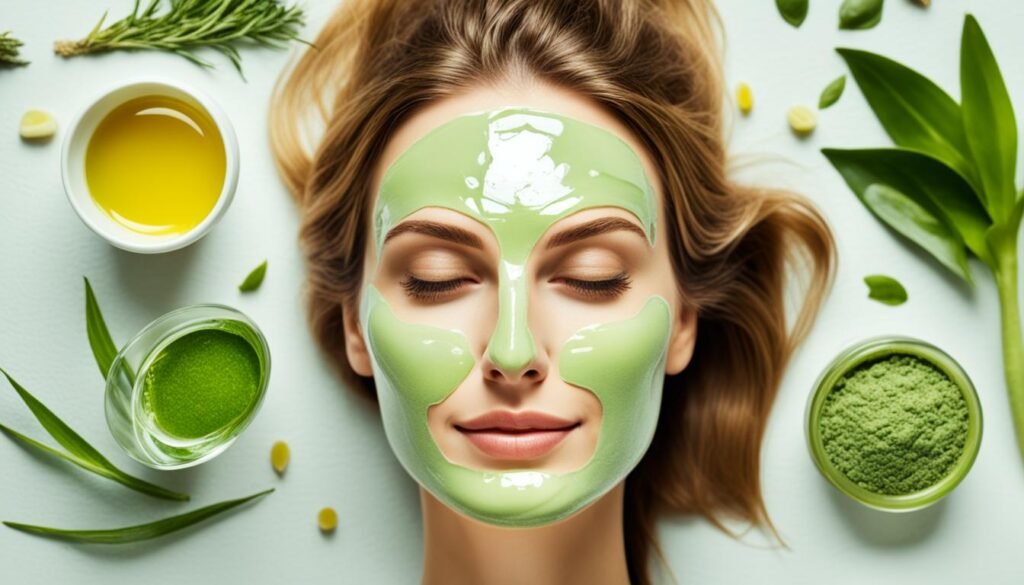
After steam cleaning the face, it is essential to nourish and repair sun-damaged skin by applying a natural serum or moisturizer enriched with topical antioxidants. Antioxidants play a crucial role in combating the damaging effects of the sun and pollution, as well as preventing the breakdown of collagen, the protein responsible for maintaining skin’s elasticity.
One commonly used antioxidant in skincare products is Vitamin E. Its powerful protective properties shield the skin from environmental stressors and lighten sunspots, helping to restore a youthful glow. CoEnzyme Q10, another potent antioxidant, works by neutralizing harmful free radicals while promoting collagen production, resulting in firmer, smoother skin.
Botanical extracts, such as green tea and licorice root, are also often incorporated into serums to provide additional antioxidant benefits. Green tea extract, with its high concentration of polyphenols, helps reduce inflammation and counteracts the effects of UV radiation on the skin. Licorice extract works to fade hyperpigmentation and even out skin tone.
When choosing a serum or moisturizer, look for products that contain a combination of these antioxidants for optimal results. They can help lighten sunspots and protect the skin from future damage, promoting a healthier, more radiant complexion.
Benefits of Antioxidants on Skin
Applying topical antioxidants to sun-damaged skin offers a multitude of benefits. Here are some key advantages:
- UV Protection: Antioxidants act as a shield against harmful UV rays, reducing the risk of further sun damage.
- Collagen Preservation: By preventing collagen breakdown, antioxidants help maintain skin’s firmness and elasticity, combating the signs of premature aging.
- Skin Repair and Rejuvenation: Antioxidants promote the repair of damaged skin cells, promoting a smoother, more youthful complexion.
- Lightening of Sunspots: Certain antioxidants can help fade hyperpigmentation caused by sun exposure, minimizing the appearance of sunspots.
- Improvement in Skin Tone and Texture: Regular use of antioxidants can result in a more even skin tone and smoother texture.
Harnessing the power of topical antioxidants is an effective way to repair and revitalize sun-damaged skin, promoting a healthier and more radiant complexion.
| Antioxidant | Benefits |
|---|---|
| Vitamin E | Protects against environmental stressors, lightens sunspots |
| CoEnzyme Q10 | Neutralizes free radicals, promotes collagen production |
| Green Tea Extract | Reduces inflammation, counters effects of UV radiation |
| Licorice Extract | Fades hyperpigmentation, evens out skin tone |
Natural Oils and Exfoliation for Sun Damaged Skin
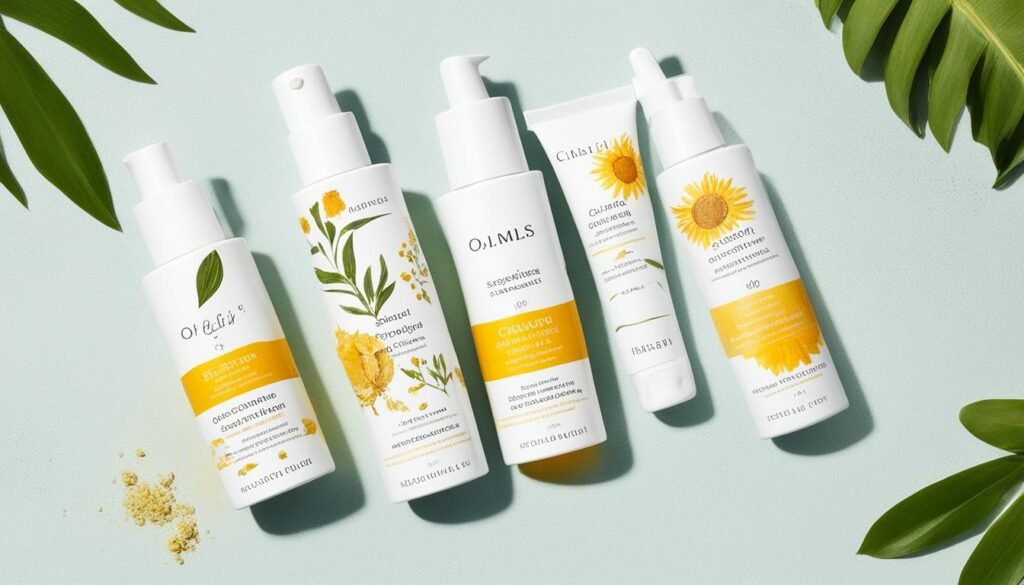
Natural oils and exfoliation play a crucial role in repairing sun-damaged skin. Incorporating these practices into your skincare routine can help rejuvenate the skin and reduce the appearance of sun damage.
One of the most effective natural oils for sun-damaged skin is coconut oil. Coconut oil is rich in essential fatty acids and antioxidants, which nourish and moisturize the skin. Its antimicrobial properties also help protect the skin from infections and inflammation.
Another beneficial oil for sun-damaged skin is rosehip oil. Rosehip oil is packed with vitamins, antioxidants, and essential fatty acids, such as omega-3 and omega-6. These nutrients promote skin regeneration, improve skin elasticity, and reduce the appearance of scars and sunspots.
Exfoliation is an essential step in the skincare routine for sun-damaged skin. It helps remove dead skin cells, unclog pores, and stimulate cell turnover, resulting in smoother and more radiant skin.
Gentle exfoliants such as sugar scrubs or facial brushes can be used to exfoliate the skin. Sugar scrubs provide a physical exfoliation, while facial brushes offer a deeper cleanse by effectively removing impurities from the skin.
Exfoliation enhances the effectiveness of other skincare products, allowing them to penetrate deeper into the skin. By removing the barrier of dead skin cells, the active ingredients in serums, moisturizers, and treatments can better target sun damage and promote skin repair.
Remember to be gentle with exfoliation, as aggressive scrubbing can irritate the skin. It is recommended to exfoliate 2-3 times a week for optimal results.
Incorporating natural oils and exfoliation into your skincare routine can help repair and rejuvenate sun-damaged skin. Coconut oil and rosehip oil provide essential nutrients and hydration, while exfoliation removes dead skin cells to reveal a healthier complexion.
Conclusion
Sunspots are a common cosmetic concern that can be effectively treated with natural remedies. By utilizing ingredients such as aloe vera, licorice extract, vitamin C and E, apple cider vinegar, green tea, black tea water, red onion, lemon juice, buttermilk, milk, honey, and over-the-counter creams, individuals can lighten and fade sunspots at home.
For those seeking more intensive treatments, professional procedures like laser resurfacing, IPL, cryotherapy, chemical peels, and microdermabrasion offer effective options to remove or reduce sunspots on the face. However, prevention is key, and limiting sun exposure, regularly applying sunscreen, and wearing protective clothing are essential for preventing future sunspots.
In conclusion, a combination of natural remedies and preventive measures can help repair and protect sun-damaged skin. By incorporating these strategies into your skincare routine, you can achieve a more even skin tone and maintain healthy, glowing skin.
FAQ
What are some at-home remedies for sun damaged skin?
At-home treatments for sun damaged skin include using aloe vera, licorice extract, vitamin C and E, apple cider vinegar, green tea, black tea water, red onion, lemon juice, buttermilk, milk, honey, and over-the-counter creams containing glycolic acid, hydroxy acid, kojic acid, or deoxyarbutin.
What professional procedures are available for sun damaged skin?
Professional treatments for sun damaged skin include laser resurfacing, intense pulse light (IPL), cryotherapy, chemical peels, and microdermabrasion.
How can I prevent sunspots on my face?
To prevent sunspots on the face, it is important to limit exposure to UVA and UVB rays by avoiding the sun between 10 a.m. and 3 p.m., regularly applying sunscreen, choosing makeup products with sunscreen, and covering the skin with clothing and hats.
What is sun damage?
Sun damage occurs from overexposure to UV rays from the sun and tanning beds, resulting in skin aging, including wrinkles and changes in texture. Sun damage is cumulative and can be exacerbated by air pollution, cigarette smoke, and household chemicals.
How does steam cleaning benefit sun-damaged skin?
Steam cleaning the face with hot water infused with citrus essential oil or peels can open pores, increase circulation, soften dead skin cells, alleviate clogged pores, and provide mood-boosting and antioxidant benefits.
How can topical antioxidants help repair sun-damaged skin?
Applying a natural serum or moisturizer containing antioxidants such as vitamin E, CoEnzyme Q10, and botanicals can repair sun-damaged skin by decreasing harm from the sun and pollution, as well as promoting collagen integrity and skin cell turnover.
Which natural oils and exfoliation methods are effective for sun-damaged skin?
Natural oils like coconut oil and rosehip oil can repair sun-damaged skin by providing essential fatty acids and antioxidants that rejuvenate the skin. Gentle exfoliation with sugar scrubs or facial brushes can also reduce the appearance of sun damage by removing dead skin cells and improving product penetration.
What are the risks of sunspots and how can they be prevented?
Sunspots are harmless and noncancerous, but it is important to differentiate them from more serious skin conditions. To prevent sunspots, limit sun exposure, wear sunscreen, and protective clothing. Seeking medical advice is recommended for any suspicious spots on the skin.
Are there any natural remedies for sun damaged skin?
Yes, natural remedies such as aloe vera, licorice extract, vitamin C and E, apple cider vinegar, green tea, black tea water, red onion, lemon juice, buttermilk, milk, honey, and over-the-counter creams can help fade or remove sunspots on the face naturally.

